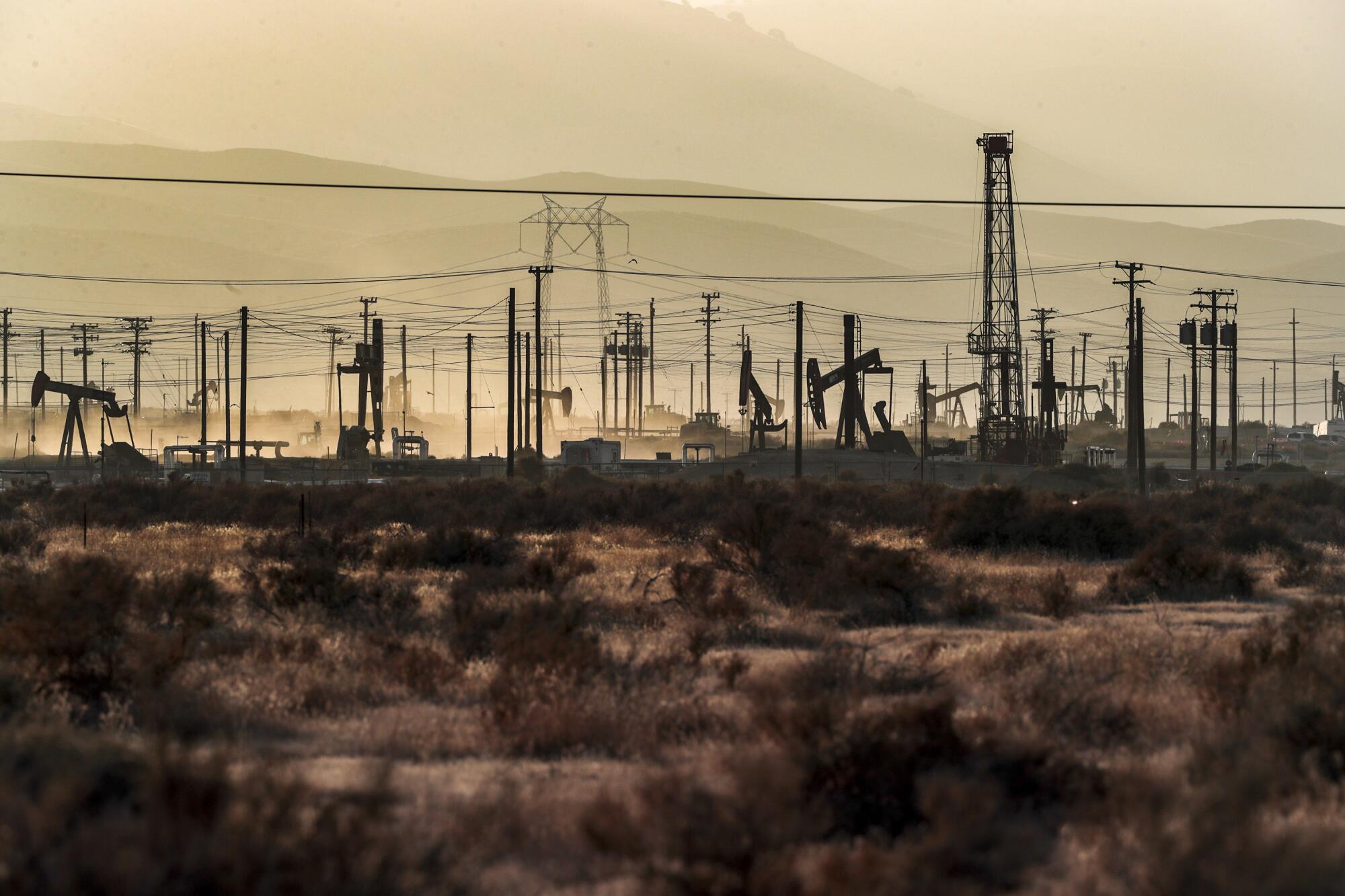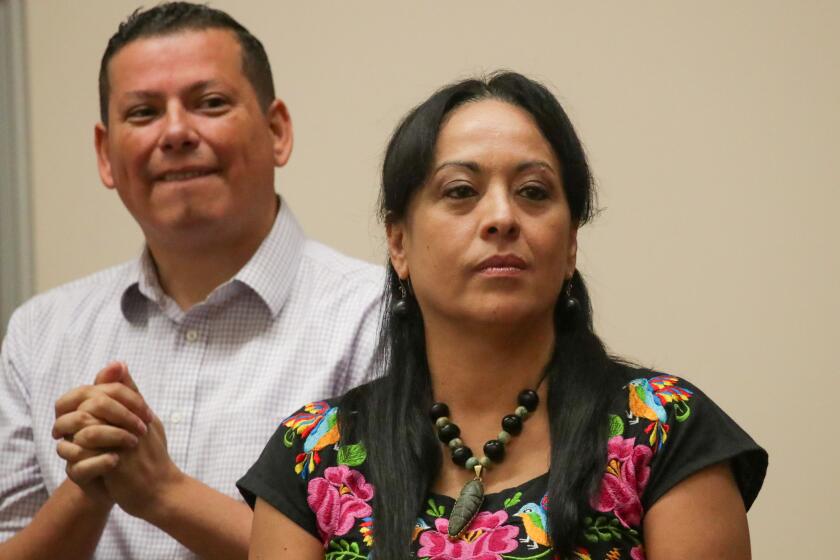
- Share via
Kern County has signed off on an oil company’s plan to permanently store greenhouse gas emissions underground in a depleted oil field, marking California’s first foray into carbon storage and a potential new role for oil and gas companies.
The Kern County Board of Supervisors voted unanimously to approve California Resources Corp.’s plan to capture up to 48 million metric tons of carbon dioxide and inject the gas one mile underground into the Elk Hills oil field, about 25 miles west of downtown Bakersfield.
For the record:
4:04 p.m. Oct. 28, 2024For the record: An earlier version of this article misidentified the organization that Ileana Navarro works for as the California Environmental Justice Network and misspelled Kern County Supervisor Phillip Peters’ first name as Philip.
After about two years of environmental reviews, the vote was the final regulatory hurdle for the state’s first carbon capture and storage project — an approach that has been described as an essential component of California’s ambitious climate plans.
In California, there are about a dozen other carbon storage proposals that seek to collectively squirrel away millions of tons of carbon emissions in old oil and gas fields in exchange for government tax credits. All of them would be located in the Central Valley.
“This is really a watershed, historic, milestone moment in Kern County,” Supervisor Leticia Perez said ahead of the vote. “Because Kern County continues to exhibit the pieces ... necessary to be on the cutting edge of any industry whatsoever.”
Perez is running for reelection for another four-year term. She represents County District 5, which includes portions of downtown and eastern Bakersfield.
The project is part of California Resources Corp.’s broader “carbon management” business model that seeks to lower the carbon footprint of industrial operations such as cement and power plants.
“It is the first time we’re bringing this technology to Kern County, but [carbon capture and storage] has been done very safely and effectively for over 50 years throughout the world,” said Francisco Leon, chief executive of California Resources Corp.
“The government of California talks about CCS as absolutely critical in order to achieve the energy transition. There’s no place better to get this started than in Kern County, the capital, the energy capital of California.”
The proposal passed despite persistent objections from environmentalists who argued that storing industrial carbon emissions underground is unproven and could endanger nearby communities if there are leaks.
Last month, a carbon storage project in central Illinois paused operations after CO2 migrated outside the injection zone due to a hole in monitoring wells. Although the migration occurred deep underground, the U.S. Environmental Protection Agency issued a violation to ethanol producer Archer-Daniels-Midland for failing to monitor the well as its permit specifies.
Perhaps the most notable leak occurred in Satartia, Miss., in 2020 when a CO2 pipeline ruptured after heavy rains. The leak led to the hospitalization of 45 people and the evacuation of 200 residents. The injection sites and pipelines have the highest risk of possible leaks.
Ileana Navarro, of the Central California Environmental Justice Network, noted that California Resources Corp. has a history of hazardous spills from its current oil and gas operations. She and others worry that it could be even trickier with CO2 — an odorless, asphyxiating gas.
“These risks are higher for workers and neighboring communities that are already vulnerable and are underserved,” Navarro said. “CRC has an unreliable record.”
Any CO2 pipelines in Kern County will be equipped with automatic safety valves, which are expected to limit leakage in the event of a rupture.
The California Resources Corp. project in Kern County is expected to capture emissions from its gas field operations. The company has expressed interest in partnering with other operations, including a proposed hydrogen plant and direct air capture facility.
The U.S. Environmental Protection Agency is considering approval of California’s first ever carbon storage project, to be in Kern County.
Although the ultimate source of emissions remains somewhat unclear, the county’s permit requires all CO2 storage to originate inside the county.
“This is analogous to permitting a shopping center,” said Lorelei Oviatt, Kern County’s director of planning and natural resources. “You permit the shopping center ... but we may not actually have identified exactly what kind of retail or other sorts of things go into the shopping center yet. This is an underground warehouse for CO2, and only the first source has been identified and analyzed as appropriate.”
The project comes with economic trade-offs. For safety purposes, the county restricted commercial and residential development above the roughly 9,000-acre injection zone, which is currently agricultural fields and fossil fuel extraction. California Resources Corp. also will need to cease producing oil and plug many of its wells, which will produce less tax revenue.
To mitigate those financial losses, the county adopted annual fees for this acreage and public safety services. Kern County officials say the project will generate about $70 million over two decades.
But environmental groups worry that the project won’t be effective at its main goal: reducing carbon emissions.
For this project, companies will need to capture, compress and transport CO2 underground — a process that requires a lot of energy and potentially could lead to more emissions.
Environmentalists worry that carbon capture and storage could incentivize companies to continue to burn fossil fuels with this equipment rather than switch to zero-emission technology. And in some cases, these projects have failed to capture as much planet-warming carbon emissions as they originally intended.
“If this project is similarly ineffective, it will force the county’s frontline communities to bear the burden of ongoing pollution for years longer than is necessary,” said Natalia Ospina, legal director for the Center on Race, Poverty & the Environment. “Kern must prioritize other direct emission reduction strategies instead of CCS. It’s an unproven gamble with a long history of worsening air pollution and threatening public health and safety. Overburdened communities in Kern County should not be the guinea pigs for this technology.”
Before their vote, many of the Kern County supervisors disagreed.
“Some of these groups that are coming down and speaking against this project, they do this all the time,” Supervisor Phillip Peters said. “They’re throwing stuff against the wall to see what sticks. ... I definitely don’t have all the answers, but continually coming down and trying to tear apart projects without bringing any solutions forward is just counterproductive.”









